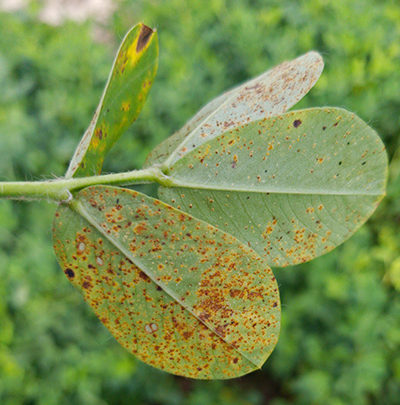Ethan Carter, Regional Crop IPM Agent, De Broughton, Regional Crop Agent, Nick Dufault, Crop Pathologist
As we near the end of August, many peanut fields in the Panhandle range from 100 to 125 days after planting (DAP). This late in the season, some growers are starting to do maturity checks, contemplate digging dates, and examining product labels for the pre-harvest interval rates.
Although growers have been battling wet weather and diseases like leaf spots and white mold all season long, one disease that they may not have on their radar is peanut rust. This disease is generally uncommon in Florida. However, in recent years has shown up in late August to early September. The wet weather and possible cooling this time of year, will create optimal environments for this disease, if it is present. It will be important to scout and use the proper late season fungicides to help manage this disease.
Peanut rust was found in Florida research plots in the Suwannee Valley this week. This is about a week earlier than when it was reported last year. Rust infestations can start small, but if not found and treated within a week or two can snowball into a full-blown management issue. Rust pustules form on the underside of peanut leaves and can be viewed with the naked eye or a hand lens.
Research from 2014, a year when rust incidence reached nearly 100% in untreated test plots, showed that treatments of azoxystrobin (e.g. Abound) and pyraclostrobin (e.g. Headline) were very effective at managing peanut rust. Treatments that had chlorothalonil (e.g. Bravo) and tebuconazole (e.g. TebuStar) also provided adequate rust management. However, only the chlorothalonil and pyraclostrobin treatments provided adequate late leaf spot management as well. It is also important to note that farmers using the leaf spot fungicide Miravis will need to combine it with a fungicide that has additional activity on rust, if this disease is present in the field. Some brand name products (e.g. Elatus, Fontelis) may also be effective against rust, but due to the sporadic nature of this disease there is limited data available about their efficacy in Florida.
–
For more information related to Peanut Rust Management, follow the article links below:
-
The What, When and How of Florida’s Peanut Rust Issue
-
Peanut Rust Fungus: Puccinia arachidis – FACT SHEET #2019003
-
Peanut Rust
- 2025 Peanut Field Day Recap & Speaker Handouts - August 29, 2025
- Peanut Foliar Diseases Exploding Across Florida - August 22, 2025
- Provisional Nitrogen Fertilization Recommendation for Florida Cotton for the 2025 Season - June 20, 2025

